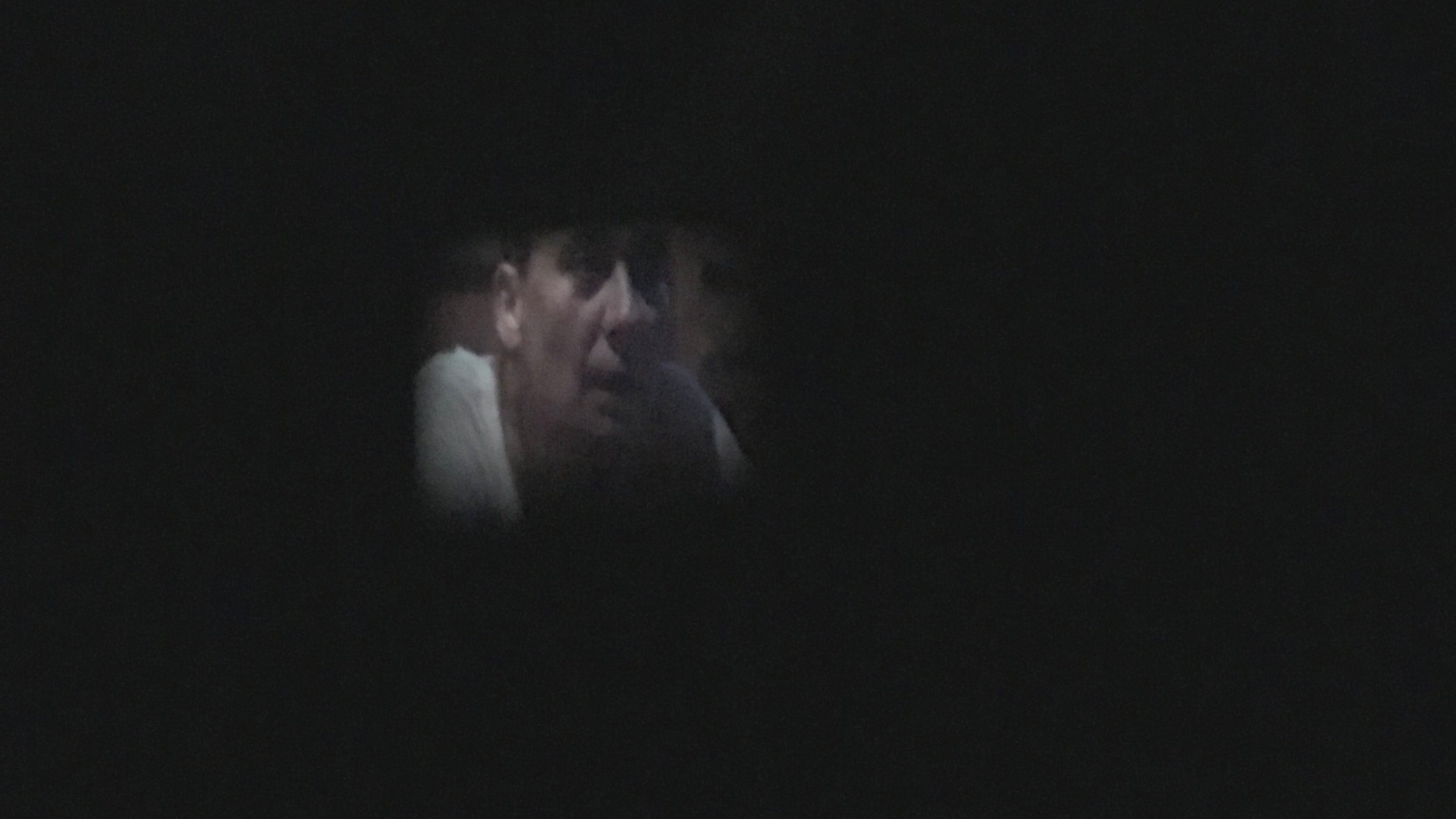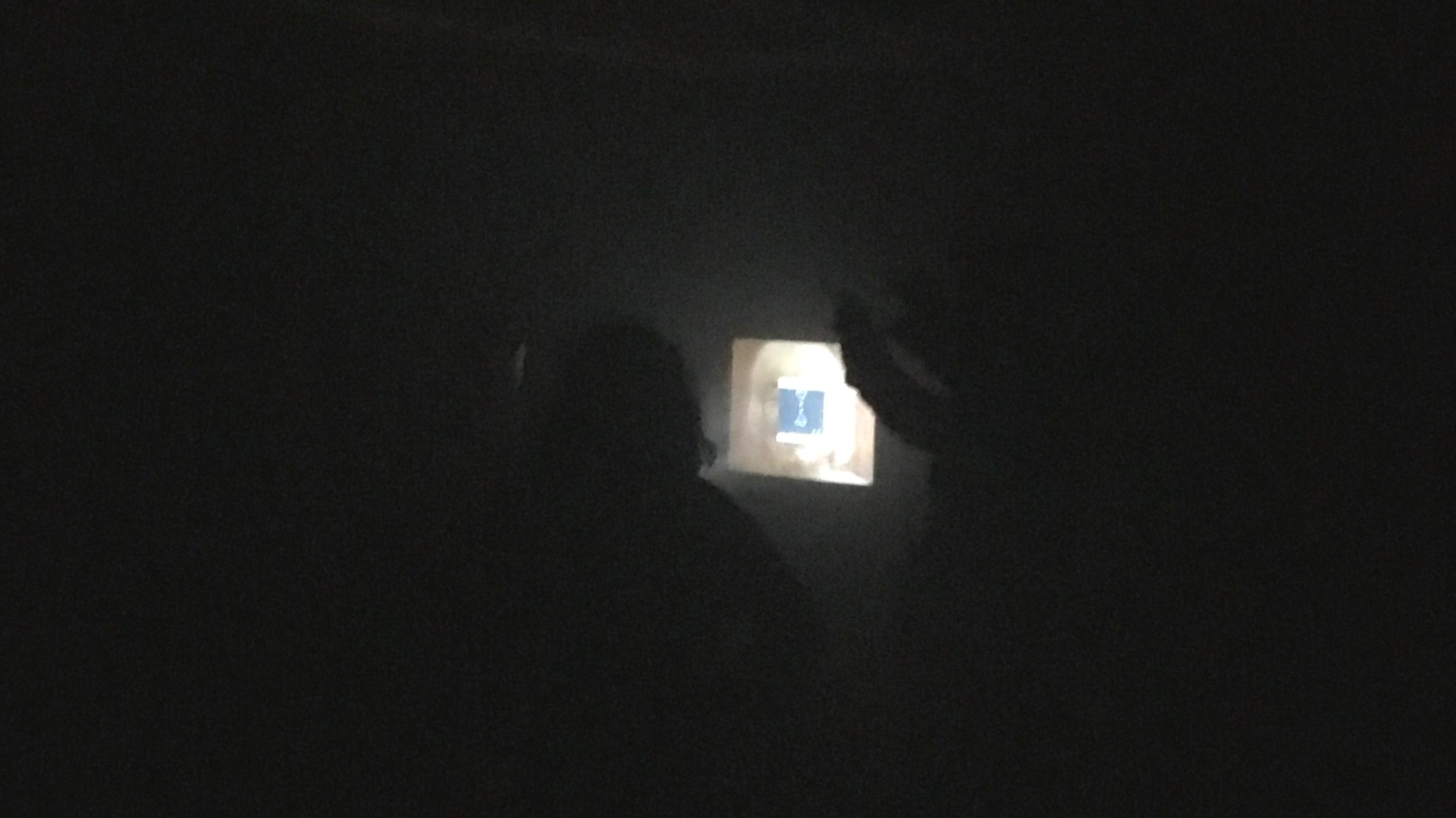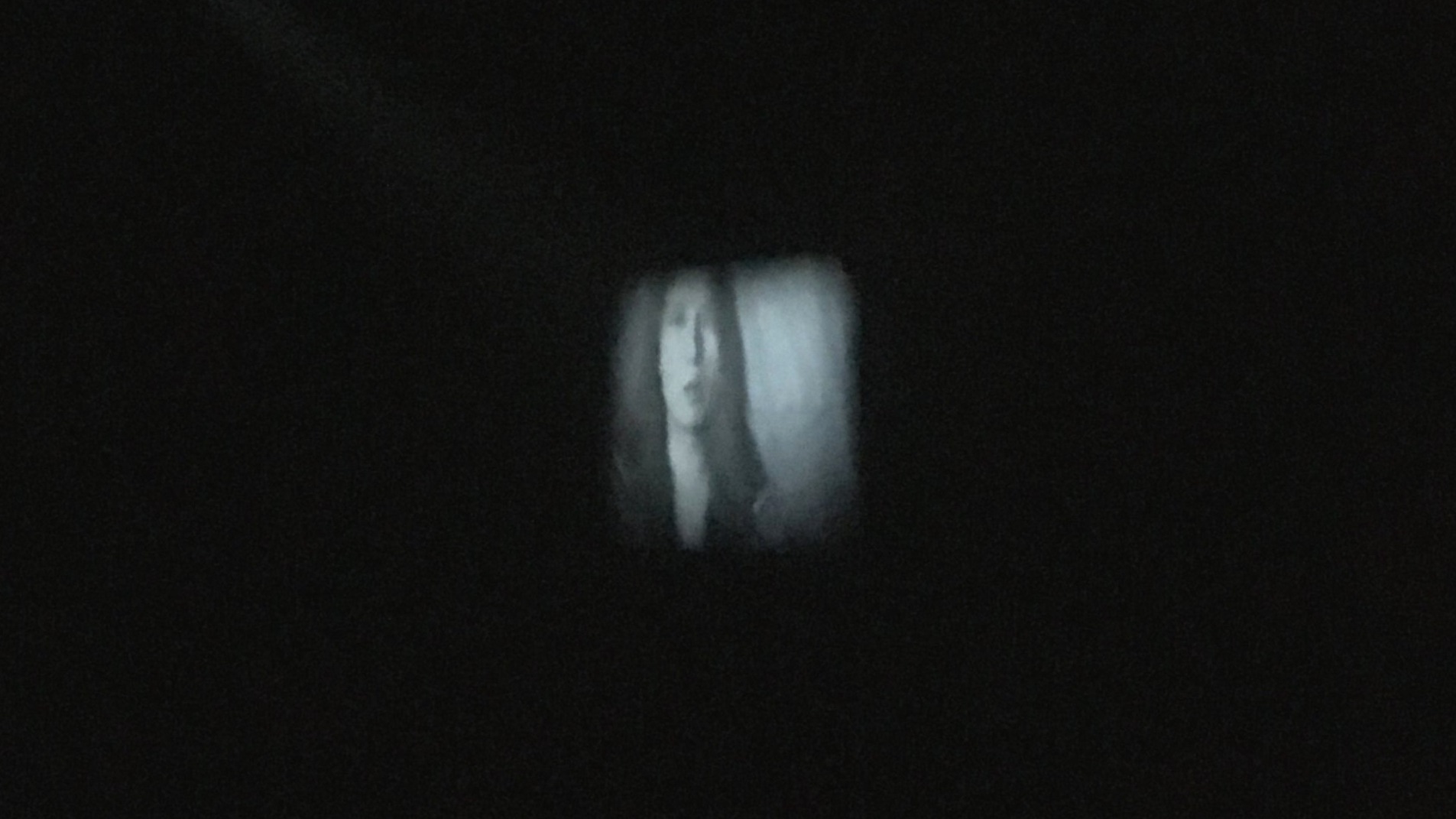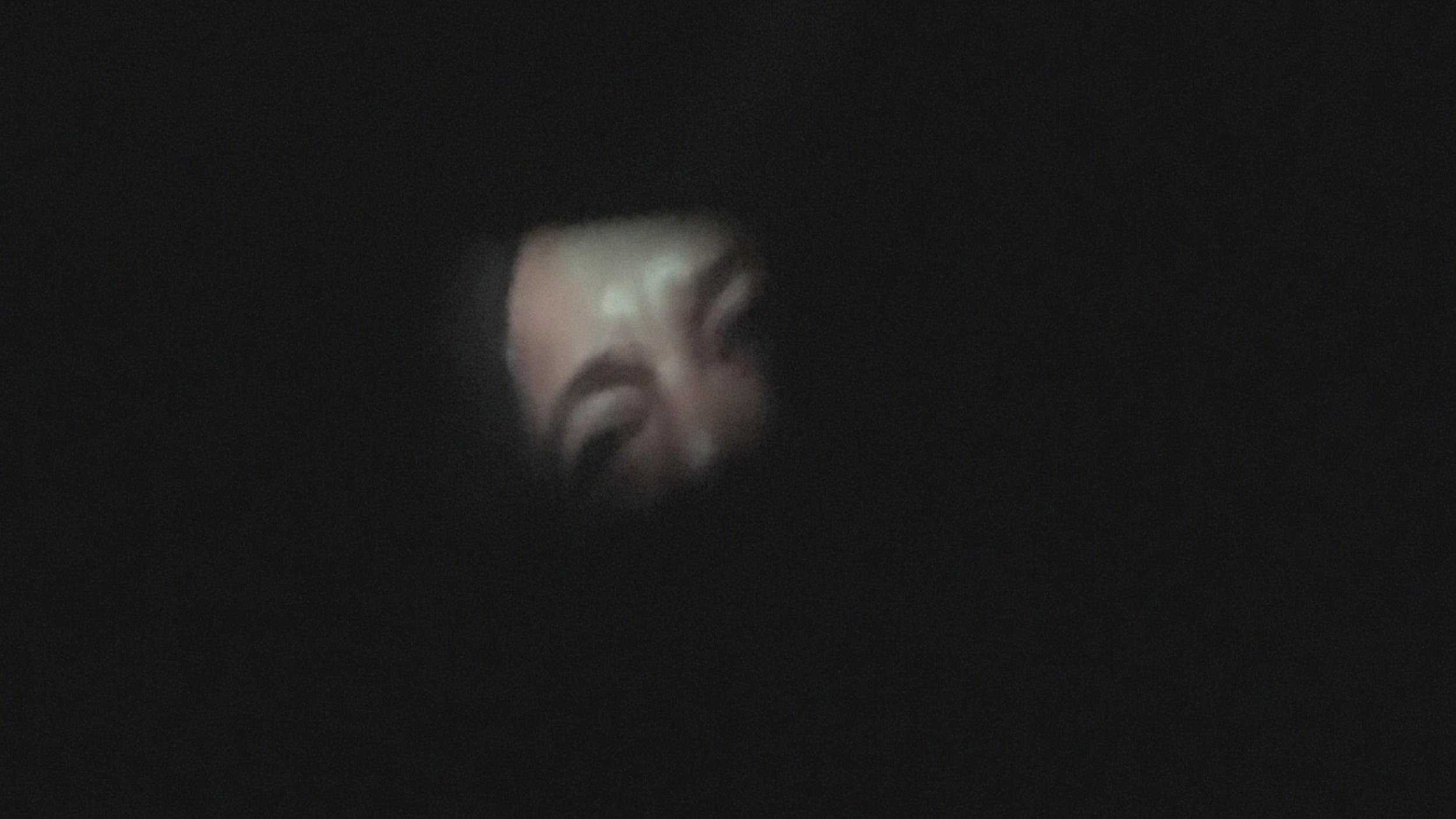11 – The show, reviews and responses
It is fascinating, watching how people react. There are 80-100 people in the room, and they are moving around much more than I’d expected. It’s perhaps too dynamic a piece to encourage sitting – though some do find a spot and stay, and afterwards a couple of people tell me they stayed in one area for most of the show, anchored to one voice. Another tells me how he chased the sounds around, chased the voices around, followed them to their source. I remember seeing him squatting over a speaker in the floor. His joy is lovely to receive. And the storytellers are elated, which is a huge relief.
What an experience, to wander with an audience, through this magical and dark story, wrapped in a literal fog. There is no way to capture this moment, no way to truly document this experience. The physicality of the sound, of the haze, at times very thick, very intense.
The theatre vs exhibition expectation is at play and my inner stage director’s nerves are frayed. At one point lights came up under the floor due to concerns about safety. It wasn’t for too long and probably didn’t break everyone’s attention, but the experiment of visual/aural information, the near-dark, dream-state, was disturbed; the spell was broken. The door opening and closing as people came and went, the lights coming up a little too quickly at the end of the show - big things in the context of theatre. Lessons learned about controlling the theatrical space.
As far as I’m able, I push aside the critical voice and focus on the soundscape. With the addition of a room full of warm bodies, the intensity of all sounds is dialled up. When the dancing feet stomp across the floor, when the whole room slowly spins, when the water of the lake rippling under our feet transforms into razor blades, when the crow flies from the centre away into the rafters, when a bell sounds up high in the centre ricocheting off the beams and I can’t remember having created this moment … when the iron door slams shut deep underground and the king’s keys rattle heavily in his fist … and then when the song, that incredible song thick with emotion, sung by 100 sentimental voices tired from dancing all night, comes swirling up through the floor and fills the room, fills our bodies with its oscillating waves, rises through the roof, fades away like a wind dissipating through treetops. How can anything I do now with sound match this physical, visceral sculpture?
An extended moment in time - about 60 minutes, and it’s over.
It is of course, not possible to replicate the experience outside of the 4DSOUND studio.
But – thanks again to Vlad, we have a binaural audio conversion. Ana and I have created a video that incorporates the six projections in the beginning, and the textural projections that were used throughout.
Using headphones, through this you can experience the (horizontal at least) omnidirectional sound field, and get a sense of this whirling, swirling dance of voices.
This is not negotiable by the way – binaural audio only works in headphones. The better the headphones, the better the spatial illusion you will have…
Reviews and responses
Paul Oomen, 4DSOUND
The project Sonority, realized at the Spatial Sound Institute in 2018, has been a unique project, in two different ways: first of all, it has highlighted new possibilities of storytelling that emerge from working with the medium of spatial sound, a way of approaching the medium that hasn’t been explored in this way before. Secondly, It introduces the notion of geographical space into the sonic experience. Geographical space, meaning the spatial and cultural dissemination and diversion by means of different dialects, different habits and therefore different ways of telling a story, has been made very explicit by telling that same story from the point of view of six different geographical locations. Since in Sonority we have six simultaneous geographical locations as our points-of-view (or rather: points-of-listening) - locations that are in fact culturally strongly connected yet diverse - , space becomes a way to make tangible the subtle personal and cultural diversions that occur within language. As such, Sonority does not just tell a story with the addition of spatial sound effects, but literally turns the auditory reality of spatial disposition and relations into its very central theme. Telling the story thus transcends the meaning of the actual story itself and becomes a vehicle for exploring the meaning of cultural and geographic relations, how and who we are, and where - our historical coming-about and potential pathways into the future.
Greenaway’s choice to build her work around a well-known fairytale, popular in the wider area of Central Europe, opens up yet another potential, which its inherent appeal to children. Through identifying with an accessible story which probably most of us have heard when we were a child, and translating that in the form of a new medium, makes this medium potentially accessible for young people, as well gives them the chance to identify with the story in unexpected ways and deeper levels that are resulting from spatial interaction. The piece becomes a potentially very powerful experience for children to identify with their cultural surrounding, highlights the necessity to embrace diversity and to experience increased empowerment of own creative role as listeners/ spectators.
We look forward to continue presenting Greenaway’s work in the future, especially to groups of children of different ages.
After the show, with Mónika, Nagy Enikő, Szabo Enikő and Csenge. Photo by Ana Amorós López.
Audience responses
“I really like how as an audience member, I felt like I was inside the stories. The nature sounds, the creaking of steps going down into the cellar, even though I couldn't understand what they were saying, I could really spatially feel like I was there … it was trance-like.”
James
“Your project brought forth many emotions in me. As a Hungarian I haven't heard the story before but many elements were familiar from other folktales what actually I listened or read such a long time ago therefore it was a bit of a time travel to my childhood and into a dreamy universe. Listening the sentences from different loudspeakers made me walk around in the space what gave a special dynamic to the whole performance. You needed to be curious to seek the new information to avoid missing any part. The visuals, sound effects and the rusty voice of the official storyteller women created a unique atmosphere in the space, I still have goosebumps from it.”
Dorottya
Review – Datson Hughes
Sonority I: Magyar – Dancing on Blades – Spatial Sound installation by Lisa Greenaway with video by Ana Amorós López
Premiere performance at 4DSOUND Experimental studio - Art Quarter Budapest.
30 November 2018During our residency at the Art Quarter Budapest (AQB) we had the privilege of being present at the premier performance of sound artist and linguist Lisa Greenaway’s Sonority 1 project. During her six-month residency at the 4DSOUND Spatial Sound Institute which is attached to the AQB, she collaborated with the place and its people, stories and sounds, using the voice, the story and the storyteller as compositional and philosophical elements to create a remarkable spatial sound experience.
The piece begins the moment one steps into the ethereal space of the 4D studio which occupies three stories of a warehouse building on the Buda side of the Danube. We stand on a mesh floor in the midst of a grid of individual speakers hung in layers: high above, at ear level, at floor level and the bass way down on the ground on the floor below.
Cocooned, as if in a cloud we wander through the space. Gradually the sound of a forest after rain takes up all aural attention - of water dripping from deep green fronds, of birdlife and a ‘thousand magnified insecta’. We wait, watch and wonder what will unfold.
Six beams of light, three each side, project images of six different female faces speaking. These are the storytellers, all highly regarded experts in their spoken word /linguistics field. Close up and animated in frames about the size of a laptop screen, they introduce themselves. The relative size of the image has the effect of making the storytellers seem visually distant, ‘at the wrong end of a telescope’.
Soon the light fades and the visual images of the faces dissipate and dissolve into loose, indeterminate shifting shadows, giving the impression of heavy eyelids coming down like curtains as the storytellers voices rise and begin their polyphonic tale. Greenaway collaborated with filmmaker Ana Amorós López on the film aspect of the work. As the eye relaxes into perception of her sparse, abstracted use of light without any narrative information, the mind focuses on the voices.
Six female voices from six points in space around the room speak in six different dialects of magyar (Hungarian) from Hungary’s six regions. All tell the same old Hungarian folktale - The Dancing Princesses. The seventh storyteller is Greenaway’s sound design comprising field recordings of environment, dance, music from the region along with effects and electronic musical elements to invite audiences into the story world.
Flashback to childhood anticipation of story time, all flushed from bathing and expectant of the warm mother-tongue that will lick and nudge us off the precipice of wakefulness into the world of dreaming.
Folk tales follow the logic of dreams and are deeply encoded with the social substrate of how the culture works, encouraging us to listen deeply, to close our eyes and conjure imagery out of vibrational patterns. Folk tales fortify our emergent sense of self and interiority. The fortunate preliterate child hears bed-time stories delivered lip-to-ear, to heart, in their parent’s voice. Enveloped in its reassuring vibrational embrace, they take the imaginary monsters of the waking world with them into the unconsciousness of sleep, prepared for whatever dreams may come.
The unfortunate child only receives standardised and sanitised Disney versions of the old tales, narrated in an American-accented chipmunk vocal range, and serially lacking any idiosyncratic nuance.
The Dancing Princesses has many variants, but all have the similar root narrative of a group of princesses who nightly descend to the underworld from whence they emerge each morning with their slippers slashed to pieces. The king/ father/ patriarch is troubled, or angry because they will not divulge their secret. He is prepared to marry off his daughters and offer up half/all his kingdom to a stranger who comes from outside the realm to find out where the wayward daughters go at night. Their deceit is discovered by a suitor who follows them, gathers various proofs of their guilt, informs their father and wins one of the princesses, usually the youngest, for himself. Is the damage to their soles synonymous with their endangered souls?
The effect is mesmerising.
We begin to perceive the beautiful sonic illusion that Greenaway has created in which to cradle the story, becoming conscious of what is audible beyond the voices. In the beginning, the space of the room felt bright, with the sounds of the forest up close, but as the story unfolds, we find ourselves in a sonic web of suspended disbelief where mimesis shifts to diegesis and back again.
Using the immersive, omnidirectional 4DSOUND studio system, the artist can create the illusion of moving the various elements of her sound collage through the omnidirectional grid of speakers, mimicking the spatial reality of sound that emanates from all around us in nature. The ear and the body receive fronts of pressure from different sources in the grid within the 4D ‘speaker box’, as it does in the real world. The extraordinary experience of hearing recorded sound in this way can only really be fully appreciated in the environment of the 4DSOUND studio.
This highly experimental work takes full advantage of the capacity of the system to shape space with sound. In the limited time available during her residency, the artist understood the system’s possibilities and mastered the technical complexity of its application to the extent that her manipulation of the sound field somehow dissolves the inside/outside illusion of our porous horizon of self.
We perceive our finite body and think that is where we end. The feeling of containment and isolation is further reinforced by our becoming so visually oriented. These days, our attention is more often attracted by the flicker of a screen and we focus our hearing on one, perhaps two directional speakers. All the sound mixing is done for us, contained and set in density and intensity before it reaches our own inner ‘mixing console’.
4DSOUND manipulation adds a whole new dimension to listening to recorded sound. It is little like being turned inside out. Greenaway’s delicate and subtle creation of the magical realm of the tale transforms one’s inner ear into a king’s audience chamber, an underground secret passage. She transports our awareness through space on a boat ride across a nocturnal lake, through forests of diamond, silver and gold to an enchanted island, and a magical ballroom. We hear the princesses abandon themselves to the music underpinned by the swirling dancing rhythm of the vocal narrative.
It must have been such a pleasurable experience for the local audience to hear Greenaway’s treatment of one of Hungary’s best loved tales, but as non-magyar speakers we are forced to dig deeper for comprehension and meaning, to mine the unfolding work for the underlying music of speech and reveal the patterns of emotion that all humans recognise. It is not what the story is about, but how it is heard that is the point.
Geoffey DATSON HUGHES Annnette
AQB Artists in residence November 2018



